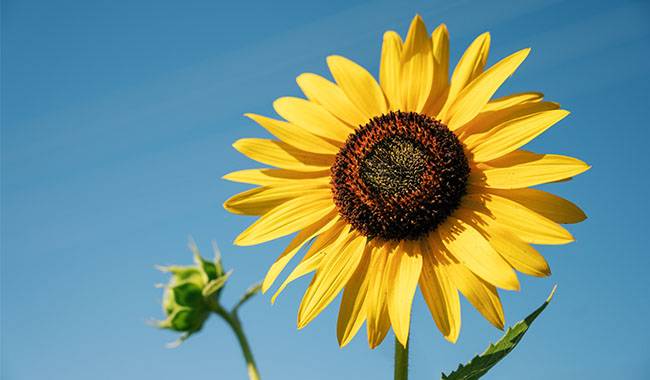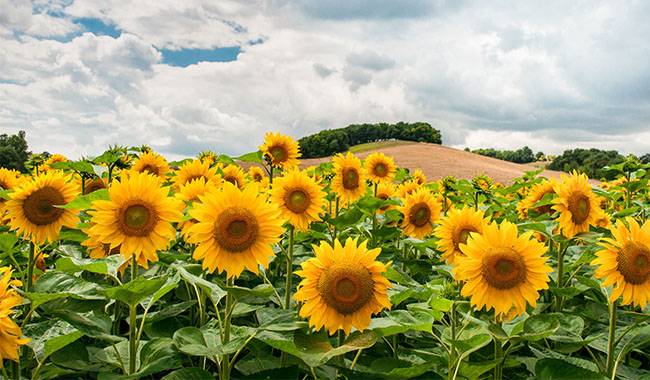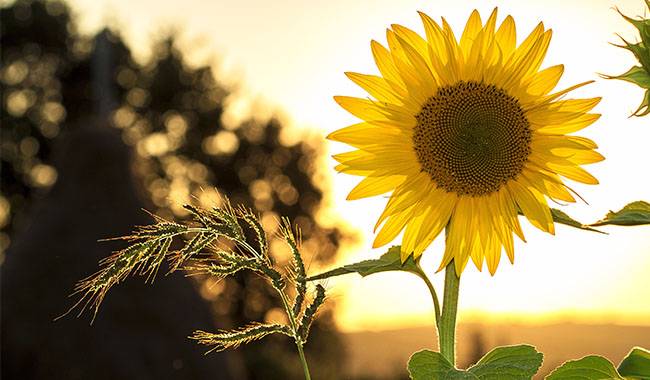
Sunflowers are native to South America. Interestingly, these seeds were only used to feed livestock at first. But soon people tried sunflower seeds, which became an inexpensive delicacy.
However, sunflower oil was not exploited until 1840. Sunflower seeds are rich in vitamins, minerals, proteins, and polyunsaturated fatty acids.
But for them to be of maximum benefit to the body, they need to be consumed in their unheated processed form. I will reveal my secret to a bountiful sunflower harvest in this article.
There is a misconception that sunflowers always turn their heads to follow the sun. But this is only partially true. Only young plants turn their heads. Adult sunflowers with mature heads do not turn them, but they keep them in one position during the day. They most often “look east”.
Sunflower – the sunniest place!
Annual sunflower or oleander sunflower (Helianthus annuus) is a very light-loving plant that needs good light to grow and develop smoothly. So I chose the sunniest place without any shade all day and night.
Soil for preparing seeds
The soil for sunflower must be prepared before sowing. The soil should be loosened shallowly to a depth of 4inch (10cm) immediately after the previous crop is harvested.
My husband does the tillage in the mid-tiller and we have a nozzle with a height of 8-12inch (20-30 cm). Then, in the fall, my husband goes through with the power tiller once again.
A week before sowing sunflowers in the spring, we loosen the soil again. As a result, it becomes very soft, loose, and saturated with oxygen. It may be hard work, but it is worth it for the bountiful sunflower harvest.
Sunflower nutrition
Sunflower is a very large plant, so it needs a lot of nutrients. It needs enough nitrogen, potassium, and phosphorus. Therefore, before loosening the soil in the fall for future sunflower plantings, I spread humus from compost and ashes on the soil.
In this way, I added nitrogen and potassium. Phosphorus for sunflowers comes from mineral fertilizers, which I apply at the last loosening of the soil, one week before planting.
Once every 10 days, during vegetation and flowering, I give the sunflowers a weed infusion. In this way, I provide my sunflowers with everything they need.
Proper crop rotation
Sunflowers should be rotated. 5-6 years before they return to their old place. Therefore, it is best to sow after a cereal crop, such as corn.
In order not to confuse what I planted, where, and when, I kept a notebook in which I sketched out my vegetable garden scheme by year. By the way, in the same notebook, I kept a sheet with a schedule for watering and fertilizing.
And here’s another secret – I always plant corn (the precursor to sunflowers) and peas together so that the soil has a supply of nitrogen, which sunflowers really like. Sunflowers will grow well on virgin land where nothing used to grow, but it is still important to prepare the soil in advance.
Selection of sowing date
The minimum germination temperature for sunflower seeds is 37°F (3°C) and the maximum is 82°F (28°C). The optimum temperature for plant growth and development is 68-77°F (20-25°C).
Air temperatures below 59°F (15°C) and above 77°F (25°C) will reduce oil synthesis in the seeds.
Sunflower grows on open land in my area, so I have little influence on the weather. However, it is very important to consider the effect of ground and air temperature on the timing of sowing. If seeds are sown too early, they will simply rot.
A late sowing date (too high temperature) will inhibit the normal development of the plant. I measure the soil with a thermometer. When it has warmed up to 46-53°F (8°C-12°C), I sow sunflower seeds.
You should leave room for sowing sunflowers
I sow sunflowers from dry seeds. I put three seeds per plant because not all of the seeds will germinate.
If a few seeds will germinate, then cut off the extra seeds with scissors. The distance between seeds I do 10-12inch (25-30cm). The sowing depth is 2inch (5cm).
Usually, I make the furrows to the desired depth, without strongly compacting them (with the narrow side of the plate, for example) and as a matter of fact, sprinkle them with water. Then, I spread the seeds at the appropriate distance and gently cover them with soil.
When the green mass begins to grow, water heavily.
Sunflowers need to be watered well while developing their green quality. However, during the seed germination period, sunflowers are drought tolerant and do not need additional water.
The roots of adult sunflowers develop very deep and are able to take water on their own. So, I water my sunflowers well with warm water (southern conditions) almost every day as they grow, and when the flower heads start to mature, water only during drought.
By the way, if you are sowing sunflowers as ornamentals in your neighborhood, it is best to choose a spot near a water source.
Care and disease prevention
If the plants are well developed, they do not need to be tied. But sunflowers definitely need regular weeding! If there is a lot of rain in spring, I will spray some fungicide twice to prevent diseases. The first time – during the emergence of flower buds and the second time – at the end of the flowering period.
Bird control
Birds are the main pests in sunflower cultivation and they can leave you with no crop at all. Therefore, it is important to put various “repellents”.
For example, you can tie old discs to sticks, you can hang long brightly colored cloth bands from tall stacks, and sometimes you have to repel the birds from the sunflower plants yourself.
I once drove by a house where the woman’s stockings were stretched over the sunflower heads to keep the birds from pecking.
Harvesting
In the south of the country, sunflowers ripen in late August or early September, when the black seeds begin to fall off. Mature heads can be cut off and immediately threaded back onto the stems so that the heads dry well in the sun.
However, there is a risk that birds will steal the crop. So, I cut the sunflower heads off and took them into the house. There, on a glass balcony, they let me lie there, completely dry.
Dear reader Stick to these simple rules of sunflower growing and you will not only always get a great harvest, but you will get great pleasure from contemplating its sunflower heads.





